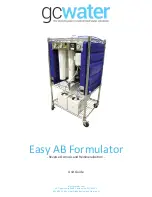
16
10. MAINTENANCE
10.1. MAINTENANCE OF THE ELECTROLYTIC CELL
Due to the Reverse Polarity System that avoids scale in the plates of the cell, the first action to
consider for ensuring a long cell lifetime is to keep the chemical parameters always in the
recommended range, especially the amount of salt, the pH and the water hardness.
1.
Keep the salinity of the water always higher than 3000 ppm in order to avoid premature
deterioration of the cell plates. The following formula determines the amount of salt to be added
in the pool due to low salinity:
Q = (4-S) x V
Where Q = quantity of salt (kg) to be added.
4 = correct salt concentration (constant).
S = Measured salt content in the pool
V = Volume of the pool in m
3
.
2.
Keep the pH between 7.2 and 7.6. Check and clean the cell plates if the system has been
working for a prolonged period with a pH value over 7.6.
3.
Check regularly the hardness in the pool water and regulate the Reverse Polarity System
indicating if water is hard, medium or soft.
ELECTROLYTIC CELL CLEANING PROCEDURE
If scale has been formed in the plates of the cell, the first cleaning procedure is the following:
1 .
Turn off power to the
SSC
one
®
unit before removing the electrolytic cell.
2 .
Once removed, look inside the cell and inspect for scale formation (light colored crusty or
flaky deposits) on the plates and for any debris which has passed through the filter and
caught on the plates.
3.
Try to remove the scale using a plastic or wood tool (do NOT use metal as this will scratch
the coating off the plates).
If the scale still remains in the plates, proceed the cell cleaning with acid solution as below:
a)
Dilute hydrochloric acid with water: one part of acid in 10 parts of water.
ATTENTION:
Always add acid into the water, NEVER add water into the acid.
This prevents splashing of the acid when the water hits it.
Wear rubber gloves and appropriate eye protection.
b)
Submerge the cell plates in the solution no more than 10 minutes. Plates plastic housing can
be submerged in the solution, but avoid any contact with the cell connections and wires.
c)
Rinse the cell with a high pressure hose. If any deposits are still visible, repeat soaking and
rinsing.
d)
If scaling persists, replace the cell for a new one.





































